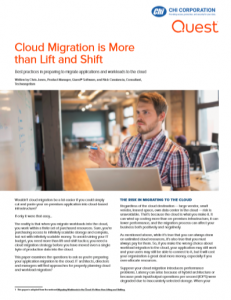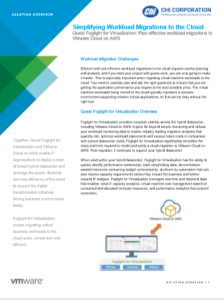Wouldn’t cloud migration be a lot easier if you could simply cut and paste your on-premises application into cloud-based infrastructure?
The reality is that when you migrate workloads into the cloud, you work within a finite set of purchased resources. Sure, you’re purchasing access to infinitely scalable storage and compute, but not with infinitely scalable money. To avoid ruining your IT budget, you need more than lift-and-shift tactics; you need a cloud migration strategy before you have moved even a single byte of production data into the cloud.
The Path to the Cloud is Paved with a Plan
So, the first step in developing a cloud migration strategy is to focus on the architecture for your cloud environment. “We have 47 VMs on premises,” you say, “so I guess that means we’ll have 47 VMs in the cloud.” Not necessarily. Where will your data be? Will it go across geographies or stay in one place? Are you subject to ingress/egress charges? When will your data be backed up? Or are you responsible for that? The environment will no longer be yours, so you have to focus on its architecture.
Next, what about your workloads and their storage/compute/networking requirements? In your own data center, nobody charges you for poorly written SQL queries, but when you’re paying for compute, wasted processing time is wasted money. Knowing what your normal usage looks like today will give you insight into how it should look once you’re running those workloads in the cloud.
Keep in mind that you have no storage or compute if you have no networking. The availability of all your applications and workloads depends on internet access. Even if you’ve thought architecture and migration completely through, your operations are dead in the water without the internet. Will you need a second internet service provider to ensure availability?
Security has to figure in your cloud migration planning. Anything you put into the cloud you automatically entrust to whoever owns the infrastructure. How secure is it? How (and how often) can you test it to satisfy yourself that only authorized users can access your data there?
Those questions along with compliance requirements drive some companies to go hybrid and keep some data in their domain on premises. But having two networks also means an expanded attack surface. And growth into new data from machines and the Internet of Things brings new exploits and vulnerabilities as well.
Optimize your Virtual Infrastructure with Foglight for Virtualization by Quest
Foglight for Virtualization lets you visualize, analyze and optimize your virtual infrastructure. With Foglight for Virtualization, you can clean up waste and expose the impact of changes, both VMware- and user-initiated. Its support for multiple hypervisors lets you drive your organization’s virtual and cloud migration strategy across VMware, Hyper-V and OpenStack. Plus, the monitoring, automation and real-time analytics in Foglight for Virtualization
complement other cloud migration tools by helping you detect waste and reclaim over-allocated resources, ensuring that you buy hardware only when necessary.
For end-to-end cloud migration planning, Foglight for Virtualization offers unmatched operational analytics for costs in the data center and combines it with a real-time marketplace with pricing for all available AWS and Azure instances (virtual machines). This allows you to develop cost models for your cloud migration in minutes instead of weeks.
By examining 365 days or more of data, Foglight analyzes the resource consumption and performance of a VM, factoring in peaks and troughs. As a result, Foglight is able to provide the best-fit, lowest-risk recommendations for any cloud, public, private, MSP or colocation scenario. To reduce risk even further, you can adjust the input to the Foglight migration engine to balance cost and performance as your needs dictate.
Foglight for Virtualization Cloud Migration Modeling quickly determines the best fit for your virtual machines based on the data you choose, the risks you accept and the cloud vendor you prefer. It provides details on how your costs and performance are likely to change after migrating to the cloud.
Want to learn more about how Foglight can help you develop cost models for your cloud migration?
We encourage you to review the five-minute video below and read the solution briefs. When you’re ready to give Foglight a try, contact John Thome, president of Chi Corporation, at 440-498-2312 or jthome@chicorporation.com.


